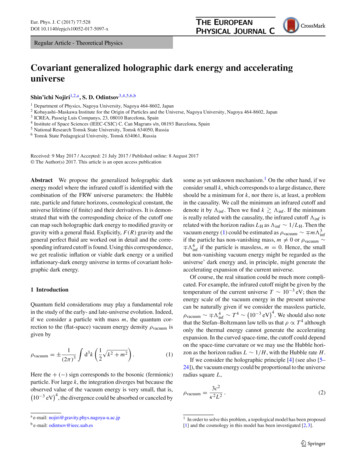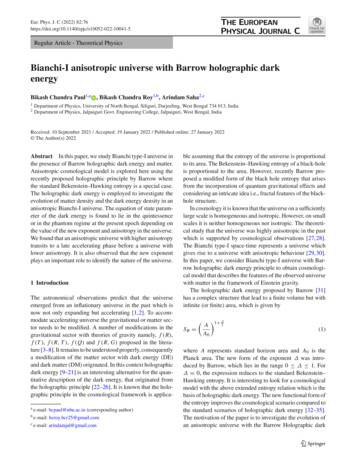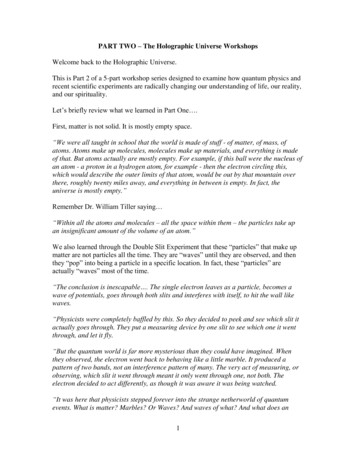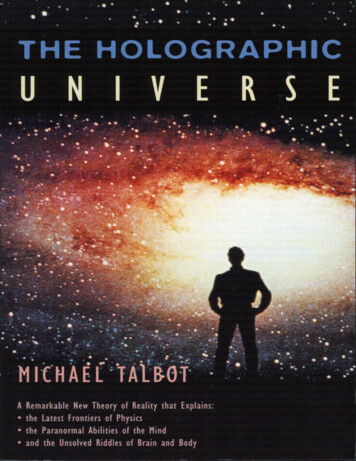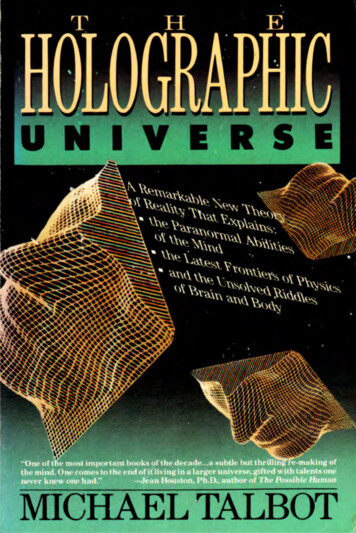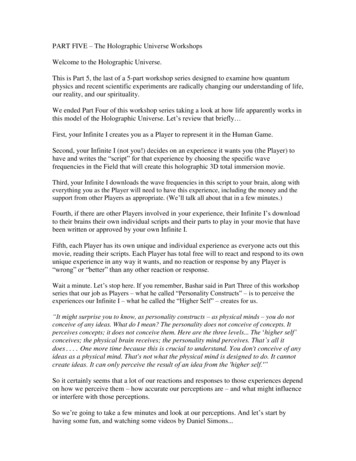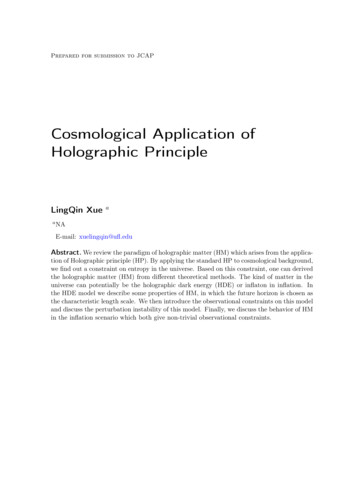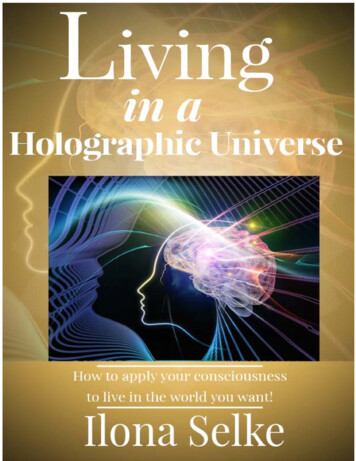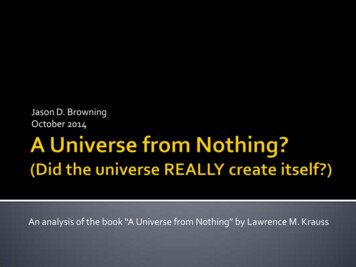
Transcription
HOLOGRAPHICUNIVERSEM. TALBOT
ContentsAcknowledgmentsIntroductionxi1PART I: A REMARKABLE NEW VIEW OF REALITY1 The Brain as Hologram112 The Cosmos as Hologram32PART II: MIND AND BODY3456The Holographic Model and PsychologyI Sing the Body HolographicA Pocketful of MiraclesSeeing Hoiographically5982119162PART 111: SPACE AND TIME7 Time Out of Mind8 Traveling in the Superhologram9 Return to the Dreamtime197229286NotesIndex303329
AcknowledgmentsWriting is always a collaborative effort and many people have contributed to the production of this book in various ways. It is not possible toname them all, but a few who deserve special mention include:David Bohm, Ph.D., and Karl Pribram, Ph.D., who were generouswith both their time and their ideas, and without whose work this bookwould not have been written.Barbara Brennan, M.S., Larry Dossey, M.D., Brenda Dunne, Ph.D.,Elizabeth W. Fenske, Ph.D., Gordon Globus, Jim Gordon, StanislavGrof, M.D., Francine Howland, M.D., Valerie Hunt, Ph.D., Robert Jahn,Ph.D., Ronald Wong Jue, Ph.D., Mary Orser, F. David Peat, Ph.D.,Elizabeth Rauscher, Ph.D., Beatrice Rich, Peter M. Rojcewicz, Ph.D.,Abner Shimony, Ph.D., Bernie S. Siegel, M.D., T.M. Srinivasan, M.D.,Whitley Strieber, Russell Targ, William A. Tiller, Ph.D., MontagueUllman, M.D., Lyall Watson, Ph.D., Joel L. Whitton, M.D., Ph.D., FredAlan Wolf, Ph.D., and Richard Zarro, who were also all generous withtheir time and ideas.Carol Ann Dryer, for her friendship, insight, and support, and forunending generosity when it comes to sharing her profound talent.Kenneth Ring, Ph.D., for hours of fascinating conversation and forintroducing me to the writings of Henry Corbin.Stanley Krippner, Ph.D., for taking the time to call me or drop me anote whenever he came across any new leads on the holographic idea.Terry Oleson, Ph.D., for his time and for kindly allowing me to usehis diagram of the "iittie man in the ear."Michael Grosso, Ph.D., for thought-provoking conversation and forhelping me track down several obscure reference works on miracles.Brendan O'Regan of the Institute of Noetic Sciences, for his imporxi
xiiACKNOWLEDGMENTStant contributions to the subject of miracles and for helping me trackdown information on the same.My longtime friend Peter Brunjes, Ph.D., for using his universityconnections to help me obtain several difficult-to-find reference works.Judith Hooper, for loaning me numerous books and articles from herown extensive collection of materials on the holographic idea.Susan Cowles, M.S., of the Museum of Holography in New York forhelping me search out illustrations for the book.Kerry Brace, for sharing his thoughts on the holographic idea as itapplies to Hindu thinking, and from whose writings I have borrowed theidea of using the hologram of Princess Leia from the movie Star ' Wars toopen the book.Marilyn Ferguson, the founder of the Brain/Mind Bulletin, who wasone of the first writers to recognize and write about the importance of theholographic theory, and who also was generous with her time andthought. The observant reader will notice that my summary of the viewof the universe that arises when one considers Bohm and Pribram'sconclusions in tandem, at the end of Chapter Two, is actually just a slightrephrasing of the words Ferguson uses to summarize the same sentimentin her bestselling book The Aquarian Conspiracy. My inability to comeup with a different and better way to summarize the holographic ideashould be viewed as a testament to Ferguson's clarity and succinctness asa writer.The staff at the American Society for Psychical Research for assistance in tracking down references, resources, and the names of pertinentindividuals.Martha Visser and Sharon Schuyler for their help in researching thebook.Ross Wetzsteon of the Village Voice, who asked me to write thearticle that started it all.Claire Zion of Simon & Schuster, who first suggested that I write abook on the holographic idea.Lucy Kroll and Barbara Hogenson for being the best agents possible.Lawrence P. Ashmead of HarperCollins for believing in the book, andJohn Michel for his gentle and insightful editing.If there is anyone that I have inadvertently left out, please forgive me.To all, both named and unnamed, who have helped me give birth to thisbook, my heartfelt thanks.IntroductionIn the movie Star Wars, Luke Skywalker's adventure begins when abeam of light shoots out of the robot Artoo Detoo and projects aminiature three-dimensional image of Princess Leia. Luke watchesspellbound as the ghostly sculpture of light begs for someone namedObi-wan Kenobi to come to her assistance. The image is a hologram, athree-dimensional picture made with the aid of a laser, and thetechnological magic required to make such images is remarkable. Butwhat is even more astounding is that some scientists are beginning tobelieve the universe itself is a kind of giant hologram, a splendidlydetailed illusion no more or less real than the image of Princess Leia thatstarts Luke on his quest.Put another way, there is evidence to suggest that our world andeverything in it—from snowflakes to maple trees to falling stars andspuming electrons—are also only ghostly images, projections from alevel of reality so beyond our own it is literally beyond both space andtime.The main architects of this astonishing idea are two of the world'smost eminent thinkers: University of London physicist David Bohm, aprotege of Einstein's and one of the world's most respected quantumphysicists; and Karl Pribram, a neurophysiologist at Stanford Universityand author of the classic neuropsychological textbook Languages of theBrain. Intriguingly, Bohm and Pribram arrived at their conclusionsindependently and while working from two very different directions.Bohm became convinced of the universe's holographic nature
2THE HOLOGRAPHIC UNIVERSEIntroduction3only after years of dissatisfaction with standard theories* inability toexplain all of the phenomena encountered in quantum physics. Pribrambecame convinced because of the failure of standard theories of thebrain to explain various neurophysiological puzzles.However, after arriving at their views, Bohm and Pribram quicklyrealized the holographic model explained a number of other mysteries asweli, including the apparent inability of any theory, no matter howcomprehensive, ever to account for all the phenomena encountered innature; the ability of individuals with hearing in only one ear to determine the direction from which a sound originates; and our ability torecognize the face of someone we have not seen for many years even ifthat person has changed considerably in the interim.But the most staggering thing about the holographic model was that itsuddenly made sense of a wide range of phenomena so elusive theygenerally have been categorized outside the province of scientificunderstanding. These include telepathy, precognition, mystical feelingsof oneness with the universe, and even psychokinesis, or the ability ofthe mind to move physical objects without anyone touching them.Indeed, it quickly became apparent to the ever growing number ofscientists who came to embrace the holographic model that it helpedexplain virtually all paranormal and mystical experiences, and in the lasthalf-dozen years or so it has continued to galvanize researchers and shedlight on an increasing number of previously inexplicable phenomena.For example: In 1980 University of Connecticut psychologist Dr. Kenneth flingproposed that near-death experiences could be explained by the holographic model. Ring, who is president of the International Associationfor Near-Death Studies, believes such experiences, as well as deathitself, are really nothing more than the shifting of a person's consciousness from one level of the hologram of reality to another. In 1985 Dr. Stanistav Grof, chief of psychiatric research at the Maryland Psychiatric Research Center and an assistant professor of psychiatry at the Johns Hopkins University School of Medicine, published abook in which he concluded that existing neurophysiological models ofthe brain are inadequate and only a holographic model can explainsuch things as archetypal experiences, encounters with the collectiveunconscious, and other unusual phenomena experienced during altered states of consciousness. At the 1987 annual meeting of the Association for the Study ofDreams held in Washington, D.C., physicist Fred Alan Wolf delivereda talk in which he asserted that the holographic model explains luciddreams (unusually vivid dreams in which the dreamer realizes he orshe is awake). Wolf believes such dreams are actually visits to parallelrealities, and the holographic model will ultimately allow us to developa "physics of consciousness" which will enable us to begin to exploremore fully these other-dimensional levels of existence. In his 1987 book entitled Synckronicity: The Bridge Between Matterand Mind, Dr. F. David Peat, a physicist at Queen's University inCanada, asserted that synchronic!ties (coincidences that are sounusual and so psyc ho logically meaningful they don't seem to be theresult of chance alone) can be explained by the holographic model.Peat believes such coincidences are actually "flaws in the fabric ofreality." They reveal that our thought processes are much more intimately connected to the physical world than has been hitherto suspected.These are only a few of the thought-provoking ideas that will beexplored in this book. Many of these ideas are extremely controversial.Indeed, the holographic model itself is highly controversial and is by nomeans accepted by a majority of scientists. Nonetheless, and as we shallsee, many important and impressive thinkers do support it and believe itmay be the most accurate picture of reality we have to date.The holographic model has also received some dramatic experimentalsupport. In the field of neurophysiology numerous studies havecorroborated Pribram's various predictions about the holographic natureof memory and perception. Similarly, in 1982 a landmark experimentperformed by a research team led by physicist Alain Aspect at theInstitute of Theoretical and Applied Optics, in Paris, demonstrated thatthe web of subatomic particles that compose our physical universe—thevery fabric of reality itself—possesses what appears to be an undeniable"holographic" property. These findings will also be discussed in thebook.In addition to the experimental evidence, several other things addweight to the holographic hypothesis. Perhaps the most importantconsiderations are the character and achievements of the two men whooriginated the idea. Early in their careers, and before the holographicmodel was even a glimmer in their thoughts, each amassed accomplishments that would inspire most researchers to spend the rest of
4THE HOLOGRAPHIC UNIVERSEIntroduction5their academic lives resting on their laurels. In the 1940s Pribram didpioneering work on the limbic system, a region of the brain involved inemotions and behavior. Bohm's work in plasma physics in the 1950s isalso considered landmark.But even more significantly, each has distinguished himself in anotherway. It is a way even the most accomplished men and women can seldomcall their own, for it is measured not by mere intelligence or even talentIt is measured by courage, the tremendous resolve it takes to stand up forone's convictions even in the face of overwhelming opposition. While hewas a graduate student, Bohm did doctoral work with RobertOppenheimer. Later, in 1951, when Oppenheimer came under theperilous scrutiny of Senator Joseph McCarthy's Committee onUn-American Activities, Bohm was called to testify against him andrefused. As a result he lost his job at Princeton and never again taught inthe United States, moving first to Brazil and then to London.Early in his career Pribram faced a similar test of mettle. In 1935 aPortuguese neurologist named Egas Moniz devised what he believedwas the perfect treatment for mental illness. He discovered that fayboring into an individual's skull with a surgical pick and severing theprefrontal cortex from the rest of the brain he could make the mosttroublesome patients docile. He called the procedure a prefrontallobotomy, and by the 1940s it had become such a popular medicaltechnique that Moniz was awarded the Nobel Prize. In the 1950s theprocedure's popularity continued and it became a tool, like the McCarthyhearings, to stamp out cultural undesirables. So accepted was its use forthis purpose that the surgeon Walter Freeman, the most outspokenadvocate for the procedure in the United States, wrote unashamedly thatlobotomies "made good American citizens" out of society's misfits,"schizophrenics, homosexuals, and radicals."During this time Pribram came on the medical scene. However, unlikemany of his peers, Pribram felt it was wrong to tamper so recklessly withthe brain of another. So deep were his convictions that while working asa young neurosurgeon in Jacksonville, Florida, he opposed the acceptedmedical wisdom of the day and refused to allow any lobotomies to beperformed in the ward he was overseeing. Later at Yale he maintainedhis controversial stance, and his then radical views very nearly lost himhis job.Bohm and Pribram's commitment to stand up for what they believe in,regardless of the consequences, is also evident in the holographic model.As we shall see, placing their not inconsiderable reputationsbehind such a controversial idea is not the easiest path either could havetaken. Both their courage and the vision they have demonstrated in thepast again add weight to the holographic idea.One final piece of evidence in favor of the holographic model is theparanormal itself. This is no small point, for in the last several decades aremarkable body of evidence has accrued suggesting that our currentunderstanding of reality, the solid and comforting sticks-and-stonespicture of the world we all learned about in high-school science class, iswrong. Because these findings cannot be explained by any of ourstandard scientific models, science has in the main ignored them.However, the volume of evidence has reached the point where this is nolonger a tenable situation.To give just one example, in 1987, physicist Robert G. Jahn andclinical psychologist Brenda J. Dunne, both at Princeton University,announced that after a decade of rigorous experimentation by theirPrinceton Engineering Anomalies Research Laboratory, they had accumulated unequivocal evidence that the mind can psychically interactwith physical reality. More specifically, Jahn and Dunne found thatthrough mental concentration alone, human beings are able to affect theway certain kinds of machines operate. This is an astounding findingand one that cannot be accounted for in terms of our standard picture ofreality.It can be explained by the holographic view, however. Conversely,because paranormal events cannot be accounted for by our currentscientific understandings, they cry out for a new way of looking at theuniverse, a new scientific paradigm. In addition to showing how theholographic model can account for the paranormal, the book will alsoexamine how mounting evidence in favor of the paranormal in turnactually seems to necessitate the existence of such a model.The fact that the paranormal cannot be explained by our currentscientific worldview is only one of the reasons it remains so controversial. Another is that psychic functioning is often very difficult to pindown in the lab, and this has caused many scientists to conclude ittherefore does not exist. This apparent elusiveness will also be discussed in the book.An even more important reason is that contrary to what many of ushave come to believe, science is not prejudice-free. I first learned this anumber of years ago when I asked a well-known physicist what hethought about a particular parapsychological experiment. The physicist{who had a reputation for being skeptical of the paranormal)
THE HOLOGRAPHIC UNIVERSEIntroductionlooked at me and with great authority said the results revealed "noevidence of any psychic functioning whatsoever." I had not yet seen theresults, but because I respected the physicist's intelligence andreputation, I accepted his judgment without question. Later when Iexamined the results for myself, I was stunned to discover the experiment had produced very striking evidence of psychic ability. I realizedthen that even well-known scientists can possess biases and blind spots.Unfortunately this is a situation that occurs often in the investigationof the paranormal. In a recent article in American Psychologist, Yalepsychologist Irvin L. Child examined how a well-known series of ESPdream experiments conducted at the Maimonides Medical Center inBrooklyn, New York, had been treated by the scientific establishment.Despite the dramatic evidence supportive of ESP uncovered by theexperimenters, Child found their work had been almost completelyignored by the scientific community. Even more distressing, in thehandful of scientific publications that had bothered to comment on theexperiments, he found the research had been so "severely distorted" itsimportance was completely obscured.1How is this possible? One reason is science is not always as objective aswe would like to believe. We view scientists with a bit of awe, and whenthey tell us something we are convinced it must be true. We forget theyare only human and subject to the same religious, philosophical, andcultural prejudices as the rest of us. This is unfortunate, for as this bookwill show, there is a great deal of evidence that the universeencompasses considerably more than our current worldview allows.But why is science so resistant to the paranormal in particular? This isa more difficult question. In commenting on the resistance he experienced to his own unorthodox views on health, Yale surgeon Dr. Bernie S.Siegel, author of the best-selling book Love, Medicine, and Miracles,asserts that it is because people are addicted to their beliefs. Siegel saysthis is why when you try to change someone's belief they act like anaddictThere seems to be a good deal of truth to Siegel's observation, whichperhaps is why so many of civilization's greatest insights and advanceshave at first been greeted with such passionate denial. We are addictedto our beliefs and we do act like addicts when someone tries to wrestfrom us the powerful opium of our dogmas. And since West-ern science has devoted several centuries to not believing in the paranormal, it is not going to surrender its addiction lightly.I am lucky. I have always known there was more to the world than isgenerally accepted. I grew up in a psychic family, and from an early ageI experienced firsthand many of the phenomena that will be talked aboutin this book. Occasionally, and when it is relevant to the topic beingdiscussed, 1 will relate a few of my own experiences. Although they canonly be viewed as anecedotal evidence, for me they have provided themost compelling proof of all that we live in a universe we are only justbeginning to fathom, and I include them because of the insight theyoffer.Lastly, because the holographic concept is still very much an idea inthe making and is a mosaic of many different points of view and piecesof evidence, some have argued that it should not be called a model ortheory until these disparate points of view are integrated into a moreunified whole. As a result, some researchers refer to the ideas as theholographic paradigm. Others prefer holographic analogy, holographicmetaphor, and so on. In this book and for the sake of diversity I haveemployed all of these expressions, including holographic model andholographic theory, but do not mean to imply that the holographic ideahas achieved the status of a model or theory in the strictest sense of theseterms.In this same vein it is important to note that although Bohm andPribram are the originators of the holographic idea, they do not embraceall of the views and conclusions put forward in this book. Rather, this is abook that looks not only at Bohm and Pribram's theories, but at the ideasand conclusions of numerous researchers who have been influenced bythe holographic model and who have interpreted it in their ownsometimes controversial ways.Throughout this book I also discuss various ideas from quantumphysics, the branch of physics that studies subatomic particles (electrons,protons, and so on). Because I have written on this subject before, I amaware that some people are intimidated by the term quantum physics andare afraid they will not be able to understand its concepts. Myexperience has taught me that even those who do not know anymathematics are able to understand the kinds of ideas from physics thatare touched upon in this book. You do not even need a background inscience. All you need is an open mind if you happen to glance at a pageand see a scientific term you do not know. I have kept67
8THE HOLOGRAPHIC UNIVERSEsuch terms down to a minimum, and on those occasions when it wasnecessary to use one, I always explain it before continuing on with thetextSo don't be afraid. Once you have overcome your "fear of thewater," I think you'll find swimming among quantum physics' strangeand fascinating ideas much easier than you thought. I think you'll alsofind that pondering a few of these ideas might even change the wayyou look at the world. In fact, it is my hope that the ideas containedin the following chapters will change the way you look at the world.It is with this humble desire that I offer this book.PART IA REMARKABLENEW VIEWOF REALITYSit down before foct like a little child, and be prepared to give up every preconceived notion, followhumbly wherever and to whatever abyss Natureleads, or you shall learn nothing.—T. H. Huxley
IThe Brain as HologramIt isn't that the world of appearances is wrong; it isn't that therearen't objects out there, at one level of reality. It's that if youpenetrate through and look at the universe with a holographicsystem, you arrive at a different view, a different reality. And thatother reality can explain things that have hitherto mena,synchronicities, the apparently meaningful coincidence of events.—Karl Pribramin an interview in Psychology TodayThe puzzle that first started Pribram on the road to formulating hisholographic model was the question of how and where memories arestored in the brain. In the early 1940s, when he first became interested inthis mystery, it was generally believed that memories were localized inthe brain. Each memory a person had, such as the memory of the lasttime you saw your grandmother, or the memory of the fragrance of agardenia you sniffed when you were sixteen, was believed to have aspecific location somewhere in the brain cells. Such memory traceswere called engrains, and although no one knew what an engram wasmade of—whether it was a neuron or perhaps even a special kind ofmolecule—most scientists were confident it was only a matter of timebefore one would be found. There were reasons for this confidence.Research conducted by Can
12The Brain as Hologram .JTHE HOLOGRAPHIC UNIVERSEnadian neurosurgeon Wilder Penfield in the 1920s had offered convincing evidence that specific memories did have specific locations in thebrain. One of the most unusual features of the brain is that the objectitself doesn't sense pain directly. As long as the scalp and skull havebeen deadened with a local anesthetic, surgery can be performed on thebrain of a fully conscious person without causing any pain.In a series of landmark experiments, Penfield used this fact to hisadvantage. While operating on the brains of epileptics, he would electrically stimulate various areas of their brain cells. To his amazement hefound that when he stimulated the temporal lobes (the region of the brainbehind the temples) of one of his fully conscious patients, theyreexperienced memories of past episodes from their lives in vivid detail.One man suddenly relived a conversation he had had with friends inSouth Africa; a boy heard his mother talking on the telephone and afterseveral touches from Penfield's electrode was able to repeat her entireconversation; a woman found herself in her kitchen and could hear herson playing outside. Even when Penfield tried to mislead his patients bytelling them he was stimulating a different area when he was not, hefound that when he touched the same spot it always evoked the samememory.In his book The Mystery of the Mind, published in 1975, just shortlybefore his death, he wrote, "It was evident at once that these were notdreams. They were electrical activations of the sequential record ofconsciousness, a record that had been laid down during the patient'searlier experience. The patient 're-lived' all that he had been aware of inthat earlier period of time as in a moving-picture 'flashback.' 'MFrom his research Penfield concluded that everything we have everexperienced is recorded in our brain, from every stranger's face we haveglanced at in a crowd to every spider web we gazed at as a child. Hereasoned that this was why memories of so many insignificant eventskept cropping up in his sampling. If our memory is a complete record ofeven the most mundane of our day-to-day experiences, it is reasonable toassume that dipping randomly into such a massive chronicle wouldproduce a good deal of trifling information.As a young neurosurgery resident, Pribram had no reason to doubtPenfield's engram theory. But then something happened that was tochange his thinking forever. In 1946 he went to work with the greatneuropsychologist Karl Lashley at the Yerkes Laboratory of PrimateBiology, then in Orange Park, Florida. For over thirty years Lashley hadbeen involved in his own ongoing search for the elusive mech-anisms responsible for memory, and there Pribram was able to witnessthe fruits of Lashley's labors firsthand. What was startling was that notonly had Lashley failed to produce any evidence of the en-gram, but hisresearch actually seemed to pull the rug out from under all of Penfield'sfindings.What Lashley had done was to train rats to perform a variety of tasks,such as run a maze. Then he surgically removed various portions of theirbrains and retested them. His aim was literally to cut out the area of therats' brains containing the memory of their maze-running ability. To hissurprise he found that no matter what portion of their brains he cut out,he could not eradicate their memories. Often the rats' motor skills wereimpaired and they stumbled clumsily through the mazes, but even withmassive portions of their brains removed, their memories remainedstubbornly intact.For Pribram these were incredible findings. If memories possessedspecific locations in the brain in the same way that books possessspecific locations on library shelves, why didn't Lashley's surgicalplunderings have any effect on them? For Pribram the only answerseemed to be that memories were not localized at specific brain sites, butwere somehow spread out or distributed throughout the brain as a whole.The problem was that he knew of no mechanism or process that couldaccount for such a state of affairs.Lashley was even less certain and later wrote, ,lI sometimes feel, inreviewing the evidence on the localization of the memory trace, that thenecessary conclusion is that learning just is not possible at all.Nevertheless, in spite of such evidence against it, learning does sometimes occur."2 In 1948 Pribram was offered a position at Yale, andbefore leaving he helped write up thirty years of Lashley's monumentalresearch.The BreakthroughAt Yale, Pribram continued to ponder the idea that memories weredistributed throughout the brain, and the more he thought about it themore convinced he became. After all, patients who had had portions oftheir brains removed for medical reasons never suffered the loss ofspecific memories. Removal of a large section of the brain might cause apatient's memory to become generally hazy, but no one ever came
14THEHOLOGRAPHICUNIVERSEout of surgery with any selective memory loss. Similarly, individualswho had received head injuries in car collisions and other accidentsnever forgot half of their family, or half of a novel they had read. Evenremoval of sections of the temporal lobes, the area of the brain that hadfigured so prominently in Penfield's research, didn't create any gaps in aperson's memories.Pribram's thinking was further solidified by his and other researchers'inability to duplicate Penfield's findings when stimulating brains otherthan those of epileptics. Even Penfield himself was unable to duplicatehis results in nonepileptic patients.Despite the growing evidence that memories were distributed, Pribram was still at a loss as to how the brain might accomplish such aseemingly magical feat. Then in the mid-1960s an article he read inScientific American describing the first construction of a hologram hithim like a thunderbolt. Not only was the concept of holography dazzling,but it provided a solution to the puzzle with which he had beenwrestling.To understand why Pribram was so excited, it is necessary to understand a little more about holograms. One of the things that makesholography possible is a phenomenon known as interference. Interference is the crisscrossing pattern that occurs when two or more waves,such as waves of water, ripple through each other. For example, if youdrop a pebble into a pond, it will produce a series of concentric wavesthat expands outward. If you drop two pebbles into a pond, you will gettwo sets of waves that expand and pass through one another. Thecomplex arrangement of crests and troughs that results from suchcollisions is known as an interference pattern.Any wavelike phenomena can create an interference pattern, including light and radio waves. Because laser light is an extremely p
the web of subatomic particles that compose our physical universe—the very fabric of reality itself—possesse s what appears to be an undeniable "holographic" property. These findings will also be discussed in the book. In addition to the experimental evidence, several other things add weight to the holographic hypothesis.
